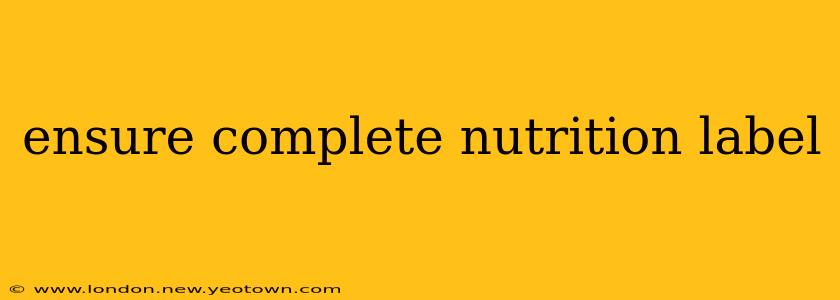Decoding the Nutrition Label: A Complete Guide to Understanding What You Eat
Let's be honest, staring at a nutrition label can feel like deciphering hieroglyphics. Those tiny numbers and confusing terms can leave even the most health-conscious among us scratching our heads. But understanding the nutrition label is crucial for making informed choices about what we put into our bodies. This isn't just about dieting; it's about fueling your body for optimal health and well-being. This guide will take you on a journey through the nutrition label, transforming it from a confusing puzzle into a powerful tool for healthy living.
Imagine this: you're at the grocery store, faced with a wall of seemingly identical cereal boxes. How do you choose the healthiest option? The answer lies in mastering the art of reading the nutrition label. This isn't about restricting yourself; it's about making informed choices that align with your health goals.
What Information Does a Complete Nutrition Label Contain?
A complete nutrition label is your roadmap to understanding the nutritional content of a food product. It provides a wealth of information, including:
-
Serving Size: This is the foundational piece of information. All the other values are based on this serving size. Pay close attention to it, as a single serving might be smaller than you anticipate. Often, people consume multiple servings without realizing it.
-
Calories: This tells you the energy content of a single serving. Calories are a measure of energy, and understanding your caloric intake is vital for weight management.
-
Macronutrients: This section breaks down the amounts of fat, carbohydrates, and protein in a serving. Each macronutrient plays a distinct role in your body's function:
-
Total Fat: Includes saturated, trans, and unsaturated fats. Pay attention to saturated and trans fats, as excessive consumption can negatively impact your heart health.
-
Cholesterol: Important for cell function, but high cholesterol can contribute to heart disease.
-
Sodium: Essential for fluid balance, but too much sodium can raise blood pressure.
-
Total Carbohydrate: Broken down into dietary fiber and total sugars. Fiber is crucial for digestive health, while added sugars should be consumed in moderation.
-
Protein: Essential for building and repairing tissues.
-
-
Micronutrients: The label also lists essential vitamins and minerals, although the specific vitamins and minerals listed will vary depending on the food product. These micronutrients play a critical role in various bodily functions.
-
Percent Daily Value (%DV): This is perhaps the most helpful aspect of the nutrition label. The %DV indicates the percentage of a nutrient in a serving relative to a 2,000-calorie diet. This allows for easy comparison between different products. A %DV of 5% or less is considered low, while 20% or more is considered high.
How to Use the Nutrition Label Effectively?
-
Start with the Serving Size: Don't skip this crucial step! Understanding the serving size is essential for accurately interpreting the remaining nutritional information.
-
Focus on the %DV: This allows you to quickly compare the nutritional content of different products. Prioritize foods with lower percentages of saturated fat, trans fat, cholesterol, and sodium, and higher percentages of fiber.
-
Read the Ingredient List: The ingredient list is listed in descending order by weight. This can provide valuable insights into the primary components of the food.
-
Compare Similar Products: Use the nutrition label to compare similar products to make informed choices based on your dietary needs and goals.
-
Be Mindful of Added Sugars: Pay attention to the added sugars content. Excessive added sugar intake is linked to various health problems.
What are the Key Differences Between Old and New Nutrition Labels?
The FDA updated the nutrition facts label in 2016. Key changes include:
-
Larger font size for Calories: Makes it easier to quickly see the caloric content.
-
Updated Daily Values: Reflects current scientific understanding of nutrition.
-
Added Sugars: Clearly indicates the amount of added sugars.
-
Serving Size Update: Reflects typical consumption patterns.
What are the common pitfalls to avoid when reading a nutrition label?
One common pitfall is focusing solely on one aspect of the label, like calories, without considering the overall nutritional profile. Remember, a balanced diet is key. Also, be aware of misleading marketing claims. Always refer to the actual nutrition facts for accurate information.
By mastering the art of reading the nutrition label, you empower yourself to make informed choices that support your health and well-being. It's a small step with significant, long-term benefits. So, next time you're at the grocery store, take a moment to appreciate the power of this small, yet mighty, piece of information!

